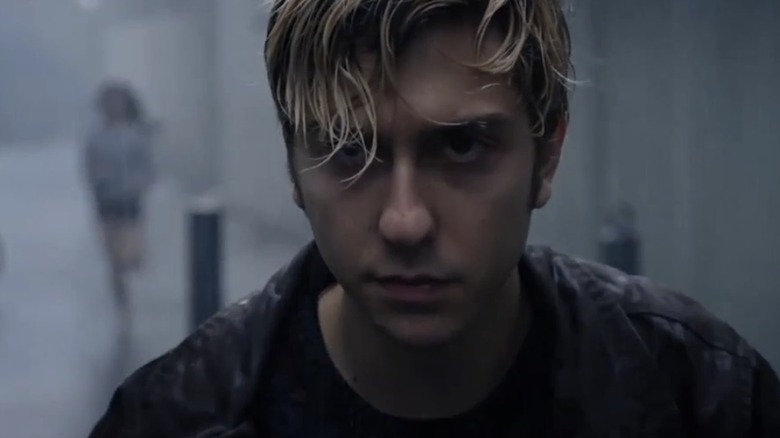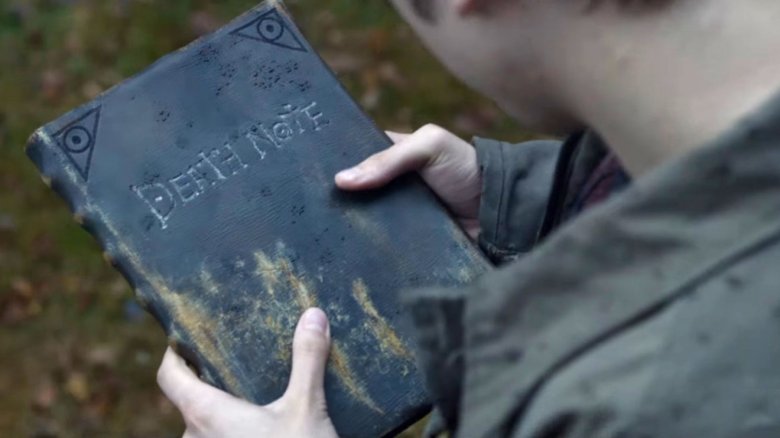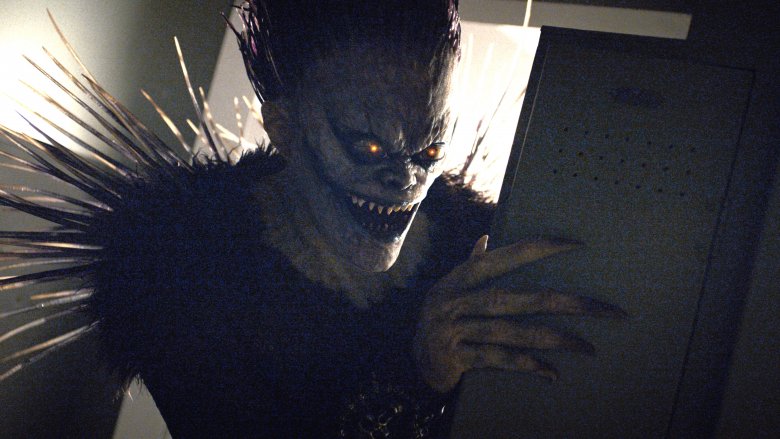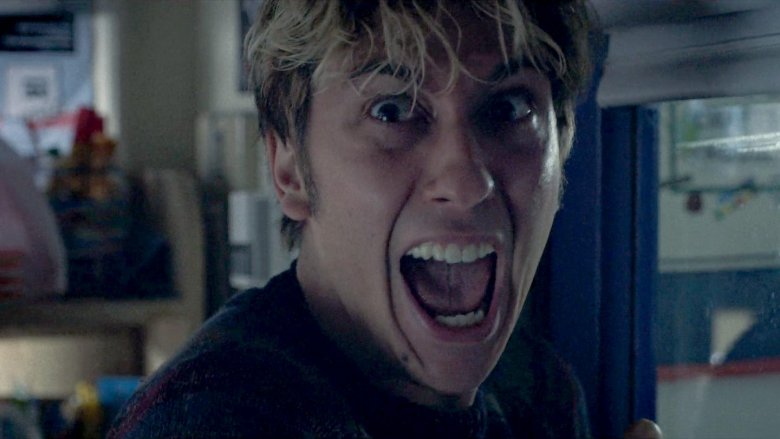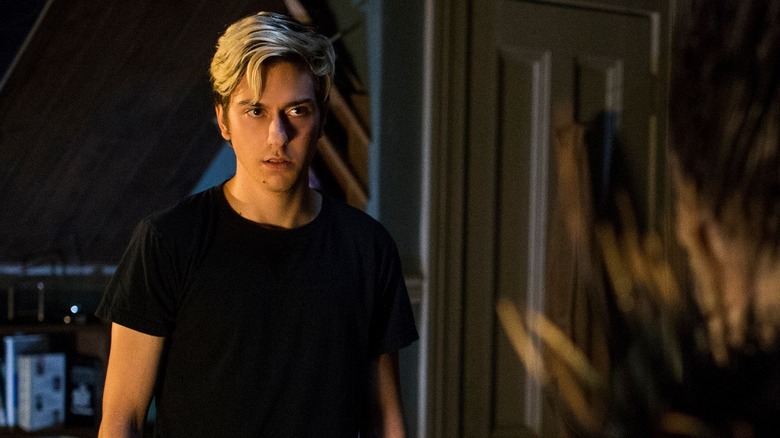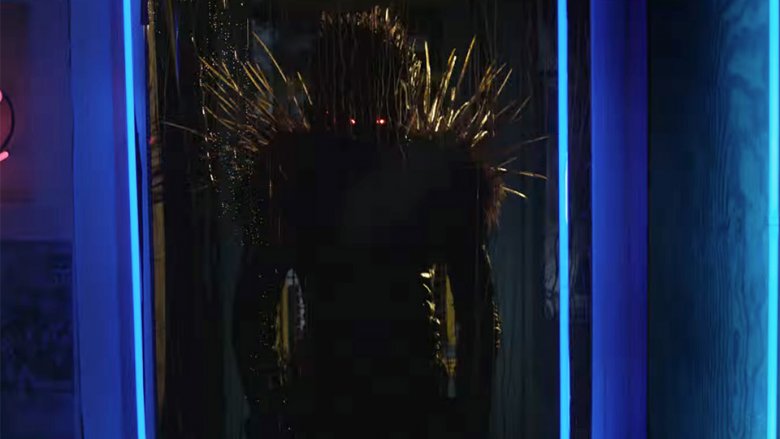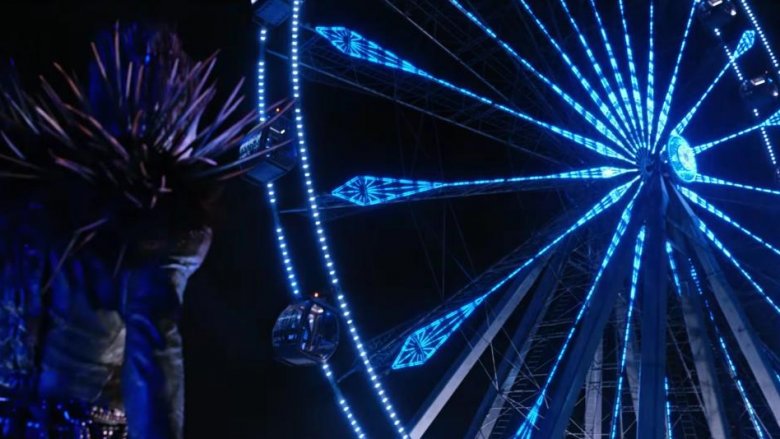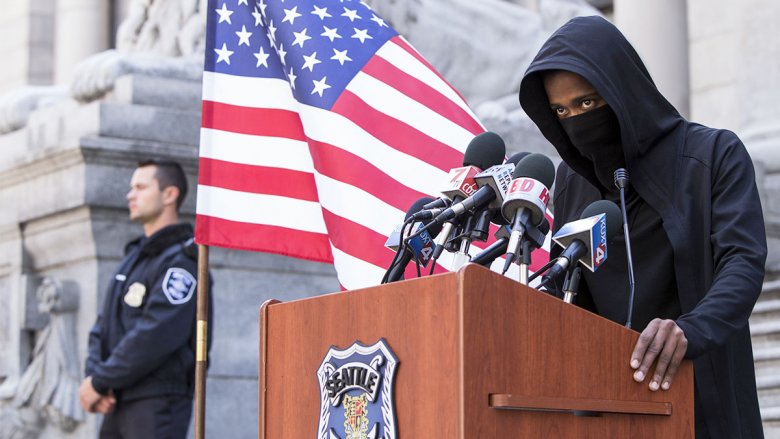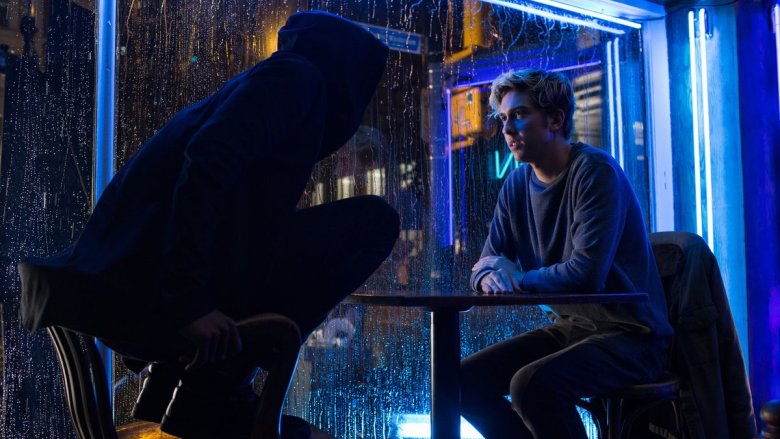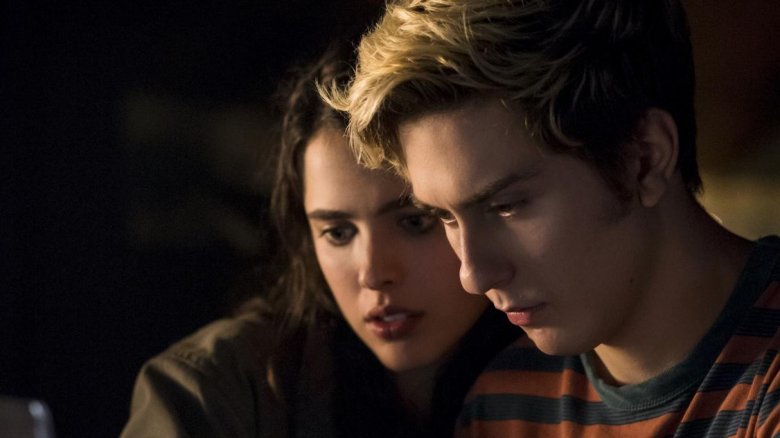The Real Reason Netflix's Death Note Movie Failed
The verdict is in, and it looks as though Hollywood's ill-fated quest to adapt an anime into a successful live-action feature is set to stumble on. Netflix was always taking a big chance by remaking a property held in such high regard by anime fans both at home in Japan and around the world, and unfortunately for them their English language, USA-set take on Death Note has not paid off.
The film has taken a real licking in reviews, with a Rotten Tomatoes critic score of 40 percent, but the more telling figure is the audience score — it holds a pretty dismal 24 percent approval rating with viewers. Death Note fans are calling Adam Wingard's movie an affront to both Tsugumi Ohba's original manga and the hugely popular anime that followed it, and this is why. (Spoilers ahead.)
It was trying way too hard
The success of Stranger Things on Netflix has led to a burst of '80s nostalgia in film and television, and Death Note shamelessly hitches a ride on that synth-heavy bandwagon. The soundtrack consists of several songs that are synonymous with the 1980s and the film employs the now typical slow-mo opening scene, reminiscent of the famous "Head Over Heels" high school scene from indie classic Donnie Darko.
Berlin's "Take My Breath Away" and Air Supply's version of "The Power of Love" are both used to dramatic effect, though rather unsuccessfully in what amounts to little more than shallow attempts to create style in the absence of any real substance. A horror director by trade (he started to get courted by the big studios after the success of his smart slasher You're Next), Wingard dabbled in '80s art-house aesthetics in his 2014 thriller hybrid The Guest, but Death Note borrows a little too heavily from the dark neon hues of films like Drive and Cold In July.
It was overly gory
The moment the trailer dropped and showed us a nightclub full of semi-naked bloodied corpses, it was clear that Wingard's take on Death Note was going to exhibit excessive amounts of violence. Ramping up the gore might have worked for the director in the past, but in using that approach for Death Note he was failing to understand what made the original manga and anime adaptation so appealing.
"I don't see the composed feeling of Death Note," one Japanese viewer said after watching the trailer, while another pointed out that there were too many action sequences. "The original version was intellectually orientated, but this version seems more action orientated," he said.
In Ohba's story, when Light Yagami (renamed Light Turner in the remake) finds the Death Note and sets about ridding the world of bad people, he does so in an inconspicuous fashion. The signature of Kira (as he dubs himself) becomes the heart attack, but not one person dies of a heart attack in this movie. Instead, the director takes what he described as a "Final Destination approach" to the killings, with Light sentencing people to death in unlikely and gruesome circumstances just for the shock value.
The soon-to-be infamous screaming scene
The issue of whitewashing in Hollywood aside, the casting of former Nickelodeon star Nat Wolff as leading man Light Turner was an uninspired one. The actor's performance has been one of the main sticking points for fans of the original anime, with one scene in particular getting singled out for some intense ridicule online.
When death god Ryuk (the owner of the Death Note that Light comes into possession of) first reveals himself to the protagonist, he does so with a display of his powers. The supernatural schemer locks the high school student in a classroom and goes full-on Poltergeist on the place, whipping chairs, tables, and everything not nailed down into a whirlwind. Wolff's reaction is already well on its way to becoming a meme — he screams in an almost comical fashion and falls over a shelf before hiding under the teacher's desk, something you'd never see the ice-cool Light of the manga doing.
They got Light all wrong
It wasn't just one moment of unintentionally hilarious screaming that ruined this new version of Light; there were numerous things wrong with his character in Wingard's remake. Manga/anime Light is such an interesting character to follow because he isn't just some kid who has come across a book that can kill people — he's a genius and genuine sociopath who relishes the chance to use the Death Note and keeps its existence completely secret for obvious reasons.
Movie Light is neither a genius nor a sociopath and only ends up becoming Kira because he's pushed down the path of murder by other characters with agendas of their own, not because he was born to be a top criminal mastermind. In the source material, Light isn't vulnerable or easy to manipulate, but having a morally ambiguous protagonist in a movie clearly aimed at a young adult audience just wouldn't fit the American model.
"It's this absolution of Light that actually whitewashes the story," Splinter News wrote. "Once again, a white American kid isn't actually responsible for the murders he commits."
Ryuk took the fall
To keep Light as innocent in all this as possible, the filmmakers needed to shift the blame for the death and destruction onto someone else, and Ryuk was one of the characters to suffer. Light's girlfriend Mia (more on her shortly) certainly plays her part in convincing him to go crazy with the the Note, but death god Ryuk is painted as the true instigator of the killing in the Netflix remake. He convinces Light to commit his very first murder (the decapitation of a school bully by way of a flying ladder) and begins manipulating him from there on in, but Ryuk's role in the original Death Note is not to edge Light towards using it — he simply tags along out of boredom because he finds Light's behavior interesting.
Willem Dafoe was born to play this role and he doesn't disappoint in it, with his distinctive tones and evil grin perfect for the part, but he can only read the script he's been given. The movie definitely would have benefited from having more Ryuk in it, though the fact that they made it so that you had to be the owner of the Death Note to see him (you only had to touch it in the manga/anime) meant he wasn't around as much as he really ought to have been.
The burning page
Only being able to see Ryuk as the owner wasn't the only change made to the rules of the Death Note. Fans were quick to pick up on other alterations to the Note's abilities and limitations, which included shortening the timespan in which a victim can be controlled by the Death Note's owner prior to death (from 23 days to just two days) and making it so that ownership of the Death Note was forfeited if it went unused for more than one week. But the most obvious change to the rules was that a person whose name is put in the Death Note can be spared if the owner burns the page on which it is written.
This concept is explained pretty early in the movie and straight away it screams plot device. It isn't even the rule itself that had viewers shaking their heads, it was the nonsensical way in which Light uses it. In the film's somewhat convoluted ending, Light manages to escape death by writing down a detailed set of circumstances involving the destruction of a ferris wheel, but within it all is a moment of sheer absurdity. The page of the Death Note with his name on it (put there by his crazy girlfriend) escapes from the accident and floats neatly down into a nearby fire, destroying itself at Light's behest. How Light manages to make this happen is unclear, as the Death Note isn't in the business of controlling inanimate objects.
It was too short
"For a film 10 years in the making, it sure feels like everyone involved is in a hurry to get it over with." That line from the Los Angeles Times review of Death Note sums it up for a lot of fans, who were left wondering why the movie was so short. At 100 minutes, Wingard's film wasn't much longer than your typical horror flick, far too short a timespan to do the detailed source material any kind of justice. These constraints meant that vital plot points had to be abandoned and relationships fast-tracked, and the result was a movie that felt rushed.
In truth, a single film was probably never enough to really capture the drawn-out battle of wits that is Death Note. The Japanese live-action version was split into two separate films for this very reason, and while both the original and the sequel were well received, even they had to skip certain elements of the manga. Netflix had the perfect platform to successfully adapt Death Note the way it needed to be done — they should have filled out the script they inherited from Warner Bros. and made it into a Netflix Original TV series playing out over ten hour-long episodes.
The relationship between Light and L was absent
The biggest casualty of the short runtime is L, who is played admirably by Lakeith Stanfield after being introduced (exhibiting all the weird behavior the L does in the manga and anime, crouching on chairs instead of sitting and chain-eating candy) but goes off the boil completely in the final act. As a legendary detective who prides himself on solving the most difficult of cases, L is as cool, calm, and collected as they come, never making a move until he has iron-clad proof that he's got his man. In the source material, L suspects Light early on but doesn't tell him this, probing him subtlely and waiting for him to slip up.
In Wingard's movie, the first time they meet L just comes out and accuses Light of being Kira, which Light more or less admits to with a wry smile. To get to this point so fast meant sacrificing the whole game of intellectual one-upmanship that unfolds between between the two, but even worse than that is sacrificing L's ethos as a character. After his longtime companion Watari is killed by the Death Note, L goes crazy, chasing down Light with a pistol and trying to blow his head off in the street. This is far removed from the L written by Ohba, who would see resorting to such tactics as a failure on his part.
The forced romance between Light and Mia
Yet another character who barely resembles the one on which they were based, Mia (known as Misa in the manga and anime) goes from being a gullible but innocent bystander to a total psycho killer in the new movie. Wingard's flick paints her as unhinged and ready to manipulate Light into using the Death Note without a second thought for the repercussions, though her botched character isn't the only problem here.
The filmmakers turned Mia and Light into a tragic love story when in the source material it was anything but. Light doesn't care about Misa enough to show her the Death Note, and he certainly wouldn't fill her in on what it did five minutes after having their first real conversation just because she knew his name. Again it comes down to the fact that American filmmakers feel the need to shoehorn Hollywood conventions into stories that were only successful to begin with because of a lack of them. The only thing Light falls in love with in Death Note is power.
